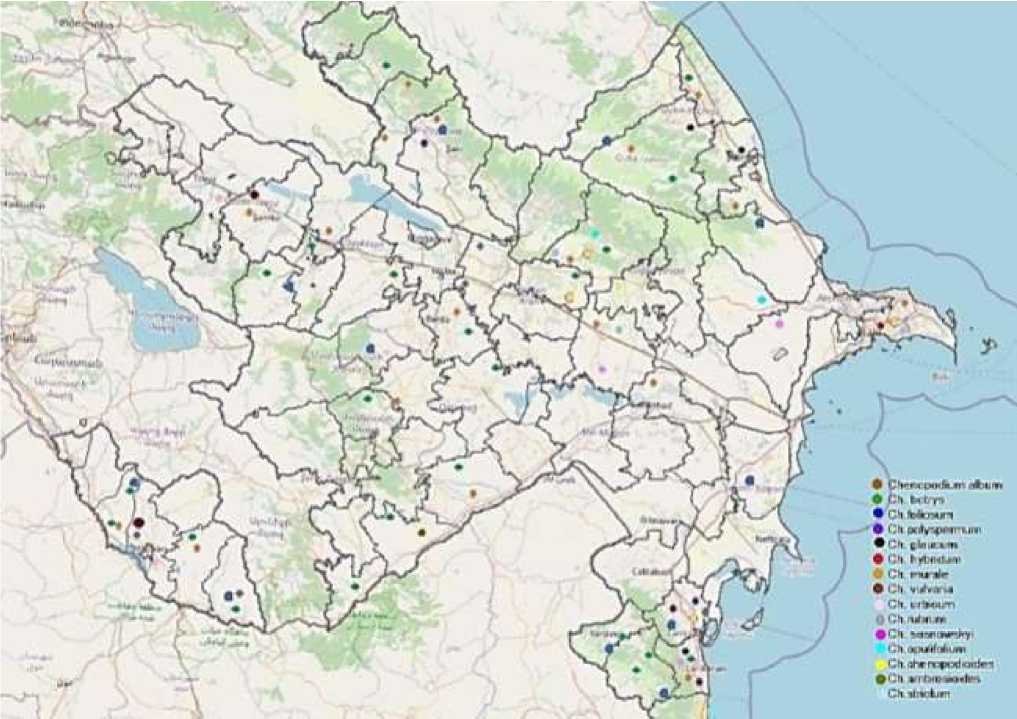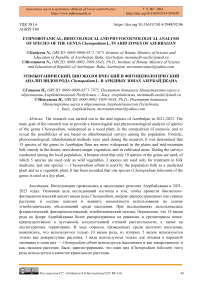Ethnobotanical, bioecological and phytocoenological analysis of species of the genus Chenopodium L. in arid zones of Azerbaijan
Автор: Ganiyeva N., Movsumova N.
Журнал: Бюллетень науки и практики @bulletennauki
Рубрика: Биологические науки
Статья в выпуске: 7 т.9, 2023 года.
Бесплатный доступ
The research was carried out in the arid regions of Azerbaijan in 2021-2023. The main goal of the research was to provide a bioecological and phytocoenological analysis of species of the genus Chenopodium , widespread as a weed plant, in the composition of coenosis, and to reveal the possibilities of use based on ethnobotanical surveys among the population. Floristic, phytocoenological, ethnobotanical methods were used during the research. It was determined that 15 species of the genus in Azerbaijan flora are more widespread in the plains and mid-mountain belt, mainly in the desert, semi-desert steppe vegetation, and in cultivated areas. During the surveys conducted among the local population, it became clear that only 10 species of the genus are used, of which 5 species are used only as wild vegetables, 3 species are used only for treatment in folk medicine, and one species - Chenopodium album is used by the population both as a medicinal plant and as a vegetable plant. It has been recorded that one species ( Chenopodium foliosum ) of the genus is used as a dye plant.
Chenopodium, arid zones, bioecology, phytocoenological analysis
Короткий адрес: https://sciup.org/14128672
IDR: 14128672 | УДК: 581.6 | DOI: 10.33619/2414-2948/92/06
Текст научной статьи Ethnobotanical, bioecological and phytocoenological analysis of species of the genus Chenopodium L. in arid zones of Azerbaijan
Бюллетень науки и практики / Bulletin of Science and Practice
In recent times, ethnobotanical studies towards discovering plants with food, medicine, fodder and other useful properties have become widespread. Ethnobotany is based on knowledge about plants that people have experimented with for many years. The collection and evaluation of this knowledge is important for the application of plants in various fields of industry.
280 species of the genus Chenopodium are distributed in the world flora. However, the taxonomic status of 221 of these species has been fully specified, while the status of the others has remained uncertain . In the territory of the republic, 14 species and 8 variations belonging to the genus Chenopodium were found in the “Flora Azerbaijan” [4], and 15 species [2] in recent studies.
It can be noted that the ethnobotanical use of species of the genus Chenopodium as wild vegetables, fodder and medicine has a long history and is of special importance [5; 6]. There is information about the presence of phenolic compounds, saponins, terpenes, and sterols in most species of the genus [7; 9]. This shows that plants can be used as antimicrobial, antiviral, antifungal, anthelmintic, antioxidant, immunomodulatory, etc. in the future [3].
The main purpose of the research was to reveal the ethnic usage methods of species of the Chenopodium genus widespread in the flora of Azerbaijan, and to analyze their bioecological and phytocenological characteristics.
Materials and methods of research
The research work was conducted in Tartar, Barda, Agjabedi, Shamkir, Zardab, Ujar and Samukh districts in 2021-2023. 256 specimens belonging to the genus Chenopodium in the Herbarium Fund of the Institute of Botany, MSE RA were analyzed, and their records were collected in the EXCEL program. Floristic and taxonomic analyses, geobotanical studies were conducted with reference to classical and modern fundamental works [10]. Life forms of plants were determined according to C. R. Raunkiaer [11] and T. I. Serebyakov [12], and ecological groups according to A. R. Shennikov [13].
Ethnobotanical studies were regularly conducted among the local population by questionnaire survey method. Data collected through direct interaction with local people and observations during visits were summarized [8]. Group meetings were held with people who had sufficient knowledge of local plants, and individual meetings were arranged with healers and plant sellers in villages to verify information.
Results and their discussion
During the expeditions, it was found that 15 species of Chenopodium genus are more widespread in the plain and middle mountain belt (photo). Most of the species are found as weeds in cultivated fields, roadsides, forestless arid areas, and pastures. The main plant groupings in which the species of the genus are distributed form coenoses as a dominant and subdominant in the Glycyrrhiza glabra - Chenopodium foliosum + Artemisia szowitziana, Salsola dendroides -Artemisia meyeriana-herbosetum, Palirus spina christi +Salsola dendroides – Lactuca serriola -Chenopodium album, Glycyrrhiza glabra + Alhagi pseudoalhagi - Chenopodium album, Chenopodium album + Dysphania botrys + Medicago minima + Chenopodium vulvaria, Artemisia lerchiana - Chenopodium album - Hordeum leporinum associations within tamarisk-saltwort- camelthorn (Tamarixeta-Salsoletum-Alhagiosum), wormwood-saltwort-licorice (Artemisieta-Salsoletum-Glycyrrhosum), ephemeral - herbs (Ephemereta-herbosae) formations in deserts and semi-deserts, steppe vegetation.

Figure. The map scheme of the occurrence areas of species of the genus Chenopodium L. distributed in the territory of the Republic
During surveys among the local population it became clear that only 10 species of the genus have ethnic use (Table).
On the basis of ethnobotanical surveys conducted among the local population, it was found that young leaves and shoots of Chenopodium album L., L., Ch. polyspermum L., L., Ch. urbicum L., Ch.ambrosioides L. species are used as food and also added to animal feed. The results of the surveys showed that the local population is little aware of the medicinal use of goosefoot species. Information has been collected that only Chenopodium album L., Ch.vulvaria L., Ch. botrys L., Ch.hybridum L. species have anthelmintic, anti-rheumatism and anti-cold effects .
Chenopodium album species is widely distributed in the territory of the republic from the lowlands to the middle mountain belts as a weed plant in gardens, orchards, plantations, roadsides, unused places, riverbeds, landfills.
Ch. urbicum is found mainly in the plains, and in some cases in the mid-mountain belts in orchards, roadsides, and weedy areas.
Ch.polyspermum species is found in the territory of the republic mainly in lowlands and lower mountain belts, river plantations, orchards, forest clearings.
Ch.hybridum is found in orchards and weed areas from the plains to the mid-mountain belts.
Table
BIOECOLOGICAL CHARACTERISTICS OF ETHNICALLY USED SPECIES OF THE GENUS Chenopodium L.
|
Latin and Azerbaijani name of the plant |
Life forms |
CO SP |
^ si 2 Q |
Methods of use |
|
|
^ s co |
•2 S К co Q CO ^ |
||||
|
Chenopodium album L.-lambsquarter goosefoot |
I |
Th |
X |
P-MH |
In folk medicine, a decoction and essence made from the roots and leaves of the plant is also used as a laxative, pain reliever, diuretic and expectorant. Young leaves and shoots of the plant are used as wild vegetables. |
|
Ch. botrys L. – Jerusalem oak goosefoot |
I |
Th |
X |
LH-MH |
A decoction made from the plant is used for headaches, colds and viral diseases, and also as an anthelmintic. |
|
Ch.foliosum Aschers. – multifoliate goosefoot |
Pere n. herb |
Hc |
X |
P-HH |
Red dye is obtained from the above-ground part of the plant |
|
Ch. polyspermum L. – many-seeded goosefoot. |
I |
Th |
Ms |
P-LH |
Young leaves as spinach or sparrowgrass are used in the preparation of dishes |
|
Ch. vulvaria L. – stinking goosefoo. |
I |
Th |
X |
P-MH |
Used in folk medicine for rheumatism, colds and nervous diseases. |
|
Ch. urbicum L. – city goosefoot |
I |
Th |
Ms |
P-MH |
After sweating, the young leaves and shoots of the plant are filtered and used instead of spinach in the preparation of roasts, dovga, puree, kata and other dishes |
|
Ch.rubrum L. – red goosefoot |
II |
Th |
X |
P-MH |
In some regions, young plants are used to prepare salad and borshch |
|
Ch.hybridum L. – maple-leaved goosefoot |
I |
Th |
X |
P-MH |
In folk medicine, infusions prepared from the above-ground part are used for treatment of cough, gastrointestinal diseases, diarrhea, arthritis, as well as in the treatment of eczema and wounds on the skin. |
|
Ch.murale L.– nettleleaved goosefoot |
I |
Th |
XMs |
P-MH |
Young leaves are used for salads |
|
Ch.ambrosioides L. – wormseed goosefoot |
Pere n. herb |
Hc |
Ms |
P-MH |
The use of the species as a vegetable is possible only in the young vegetative period |
Note: Th-therophyte; Hc-hemicryptophyte; Ms-mesophyte; X-xerophyte; XMs-xeromesophyte; P-plain; HH- high highlands; MH- middle highlands; LH- low highlands
Ch.ambrosioides is found in lowlands, sandy and weedy areas. In our republic, it is not used in folk medicine among the local population, but in several countries of the world it is used as an anthelmintic in the treatment of intestinal diseases, especially in worm diseases. Even essential oil is used in perfumery [1]. In West Africa, Nigeria, Senegal, Ghana, and Cameroon, the plant is used as a tea, poultice, and infusion in folk medicine for inflammatory processes, as purgative in lung infections, pain reliever, and antifungal agent [9].
Ch.foliosum species is a very valuable dye plant. The species is found in dry riverbeds, weed areas, pastures and roadsides from lowlands to high mountain belts.
Ch.vulvaria is distributed in almost all regions of the republic, from the lowlands to the middle mountain belts, in the weedy areas, in orchards, in gardens, and in riverbeds.
As a result of ethnobotanical studies, it was found that 5 species of the genus Chenopodium are used only as wild vegetables, 3 species only for the purpose of treatment in folk medicine, and one species - Chenopodium album is used by the population as both a medicinal plant and a vegetable plant. One species of the genus is recorded as a dye plant ( Chenopodium foliosum ).
Список литературы Ethnobotanical, bioecological and phytocoenological analysis of species of the genus Chenopodium L. in arid zones of Azerbaijan
- Al-Snafi, A. E. (2015). The chemical constituents and pharmacological effects of Chenopodium album-An overview. International J of Pharmacological Screening Methods, 5(1), 10-17.
- Askerov, A. M. (2016). Rastitel'nyi mir Azerbaidzhana (Vysshie rasteniya-embriofity). Baku. (in Azerbaijani).
- Dembitsky, V., Shkrob, I., & Hanus, L. O. (2008). Ascaridole and related peroxides from the genus Chenopodium. Biomedical Papers of the Medical Faculty of Palacky University in Olomouc, 152(2).
- Flora Azerbaidzhana (1950-1961). Baku. (in Russian).
- Gasymov, Kh. Z., Ibadullaev,a S. Dzh., Seidov, M., & Shiralieva, G. Sh. (2019). Dikorastushchie ovoshchnye rasteniya Nakhchyvanskoi AR. Nakhchyvan. (in Azerbaijani).
- Ibadullayeva, S. J. (2020). Ethnobotany of Local used Medicinal Plants in Azerbaijan Republic. J Med Biol, 2(2), 72-81.
- Kokanova-Nedialkova, Z., Kondeva-Burdina, M., Zheleva-Dimitrova, D., Bücherl, D., Nikolov, S., Heilmann, J., & Nedialkov, P. T. (2014). A new acylated flavonol glycoside from Chenopodium foliosum. Rec Nat Prod, 8(4), 401-406.
- Martin, G. J. (2014). Ethnobotany: a methods manual (Vol. 1). springer.
- Mosyakin, S. L., & Clemants, S. E. (1996). New infrageneric taxa and combinations in Chenopodium L.(Chenopodiaceae). Novon, 398-403. https://doi.org/10.2307/3392049
- Rabotnov, T. A. (1992). Fitotsenologiya. Moscow. (in Russian).
- Raunkiaer, C. (1934). The life forms of plants and statistical plant geography; being the collected papers of C. Raunkiær. The life forms of plants and statistical plant geography; being the collected papers of C. Raunkiaer.
- Serebryakova, T. I. (1972). Uchenie o zhiznennykh formakh rastenii na sovremennom etape. Itogi nauki i tekhniki. Ser. Botanika, 1, 84-169. (in Russian).
- Shennikov, A. P. (1964). Vvedenie v geobotaniku. Leningrad. (in Russian).


